We are, admittedly, a bit late leaving the harbour but out on the Shambles Bank, the Poole charter boats are visible, glowing white even through the watery haze.
It’s a bad omen when Poole skippers will pour gallons of diesel through their engines to reach Weymouth, but in the between-seasons month of April, it’s a fact of life. With the bass still a few weeks off and the black bream hardly showing, the codling all but gone and the Poole grounds heaving with little but dogfish, steaming an extra hour for the chance of a turbot is the Poole skippers’ best gamble.
My lifelong friend and part-time skipper Mark Wheadon, though, is one of life’s optimists. Back in the day, we were schoolboys who’d cycle to the pier at 4am in summer to catch mullet on float tackle, then pedal like demons to school, the slime still drying on our blazers. We always knew how to push the envelope.
Our companions are Adie Timbrell and Mark Costley – fellow optimists and angling fanatics. They got down to Mark’s boat, Banana Split, early and hauled the ollie in to sort out the previous week’s sandeels. The ollie – a store pot for bait, hung in the harbour water – proved half-filled with wrigglers and half with dead ones. For ‘dead’ read ‘stinking.’ Not a great smell to land on top of my Full English at 9am.
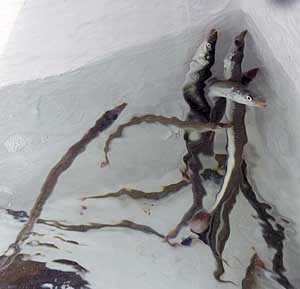 |
| Sandeels that lived |
But the lads had switched on the pump in the livebait well and the 100 or so survivors were reviving nicely as Mark fired up the engines in his unusual fishing catamaran. We trundled along the quayside, thronging with tourists enjoying the unseasonal spring weather. And on the way out, we three ‘Marks’ decided on new nicknames to avoid confusion…
Banana Split is unusual on many levels. In the first place, she’s based on a competition sailing hull; to be honest, she’s not pretty, with no rake in her prow and a lot of freeboard. No swooping curves anywhere. But her ride in most seas is supreme, she’s fuel-frugal and has plenty of deckspace for a 22-footer.
What’s more, Mark Wheadon built her. Mark’s first boat, Fru Too, came to him as a 16-foot hull into which he installed an inboard and did a fantastic job on the timber. When she came up for sale, the harbourmaster bought her. His second boat was much more ambitious; Shadowfax is a cathedral-hulled 22-footer with twin stern drives. This time, Mark did all the glasswork to join hull and deck and installed the engines. She was really fast from Day One and she’s still a working angling boat. Then he chose a 22-foot Seaworker hull, and Kithra emerged from that project.
But Banana Split was a step-change for Mark’s skills. Bearing in mind that he has a nine-to-five job, he hired the moulds and laid up the hull himself, built the deck and the cabin and installed twin Lombardini engines. All his own work, and testament to a real grafter with some serious boat-building skills. I often wonder how he managed it, but then I remember helping him tinker with an old AJS 500 motorcycle, and it all becomes clear…
 |
| Mark’s killer turbot rig |
Banana Split chunters past the float anglers on Stone Pier and hits 17 knots as we head south to the Shambles in the mid-morning haze. The sun is trying to burn through the humidity but the horizon is hidden in the milkiness, only Ringstead’s cliffs ghosting whitely on the horizon. The faint breeze has died to nothing, and our wake stretches for half a mile behind us in the mercury-calm sea.
Which is when we spot the Poole charter boats.
The previous week had yielded a handful of turbot to 15lb and some plaice, and today we are devoid of a better idea. Mark drops a cursor on the autopilot for the start of a drift which will take us along the southern edge of the bank, and Banana Split sets a course to it: “This autopilot has paid its way in fuel savings,” says Mark, and points to the plotter, showing an arrow-straight line on the marine chart.
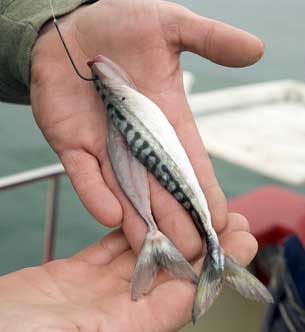 |
| Costley’s Turbait |
The on-board chatter – which until now had centred on Mark Costley’s exploits with the fairer sex – turns to rigs. Three of us go for a ‘Portland rig’, with a six-foot, 15lb nylon trace with a size 3/0 Aberdeen running along two-feet of 20lb nylon, trapped between swivels, and a 3oz ball lead on a light link. Running line is, of course, braid.
The live sandeels are rigged by passing the long-shank hook through their mouth, out through the gills and then nipped into the belly skin. I opt for a fluoro bead next to the hook. Mark Costley, I notice, has gone for a string of drilled 1oz bullets, three beads and the same trace.
As the autopilot chimes our arrival at the start of the drift, Mark cuts the engines and we wait for Banana Split to settle before dropping over the side, waiting for the lead to touch bottom, then feeding out 20 or 30 yards of line before setting the lever drag and the clicker. The technique is to bounce the leads behind the boat and over the Shambles ‘rips,’ where huge banks of crushed shell reach 20 feet to the surface. The flatfish lie between these banks, awaiting passing sandeels. At first, the sharp nodding of the rod tips shows we’re over the mussel beds, but as we drift over the rips, softer ridges make the tips nod more gently as the leads bounce along.
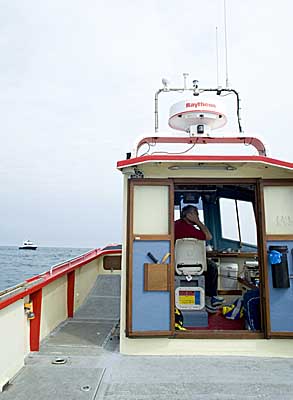 It’s a waiting game. We’re surrounded now by charter boats and private vessels, all doing much the same thing. But there’s still some pace in the tide and the baits are moving at four knots – too fast on the drift. We’d like to try to bounce the baits downtide at anchor, but once one boat is drifting, you all have to join in. An anchored boat would be a real hazard and, as our skipper points out, getting a double-figure turbot back to the boat against three four of tide would need some tougher tackle and strong arms.
It’s a waiting game. We’re surrounded now by charter boats and private vessels, all doing much the same thing. But there’s still some pace in the tide and the baits are moving at four knots – too fast on the drift. We’d like to try to bounce the baits downtide at anchor, but once one boat is drifting, you all have to join in. An anchored boat would be a real hazard and, as our skipper points out, getting a double-figure turbot back to the boat against three four of tide would need some tougher tackle and strong arms.
So we drift, haul in, motor uptide again, and drop fresh sandeels over the side, hoping for a pull. Mark Costley’s first in, on our fourth drift, and it looks like a reasonable fish. It shows minutes later – a takeable turbot but not the best reward for all the effort.
Between conversations, we used to listen to the VHF chatter. Back in the day, charter skippers were amateur comedians, delivering as many wind-ups over the radio as genuine tips. Now, there’s not much to be heard on Channel 9, and we’re tuned to Channel 16, listening to the coastguard dealing with the usual crop of minor emergencies.
Adie’s losing the will to live: “Hey,” he says. “I’ve got a great idea. Why don’t we drift up and down the Shambles catching nothing.” We discuss the options but they are all outside chances that will rack up a fuel bill with little reward. Mark Wheadon has half-heartedly dropped a string of feathers over the side and hauls up a couple of mackerel, which he lays claim to for his tea.
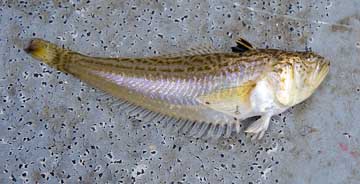 |
| Weaver fish with really poisonous spines! |
We’re all a little jaded now. In four weeks’ time, every drift will yield fish, from ‘shiners’ – small bass which flash like mirrors on the way up – to turbot, plaice and much bigger bass. But we are where we are; it’s the April angling doldrums, so we battle on, drifting the Shambles in a comprehensive way, streaking the GPS plotter with neat lines like writing paper.
Adie’s the next to catch but it’s only a fat herring. He’s taken over the feathers for a while just to add some variety to his life. Mark Costley’s had a rethink and is filleting a mackerel into two thin strips, one with the tail still attached.
“Oi!” yells the skipper. “That’s my tea you’re filleting.” Mark Costley colours up a bit; he thought he’d selected the dull-sided frozen mackerel we’d brought with us. At least, that’s what he says.
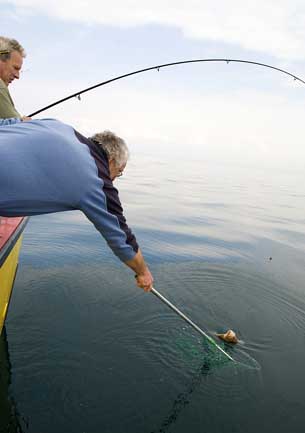 |
| A turbot comes to the net |
Half an hour later it looks as if the change of bait has paid off. Even though the tide has eased as we near slack water, his rod’s got a good bend in it. Minutes later, we discover it’s just another energetic but adolescent turbot. Is it time for a change of tactics?
We even consider heading east and finding some dogfish, but this suggestion doesn’t exactly meet with a chorus of approval. The sun’s pushing through, it’s nice and warm, Mark Costley has just fried up a pan full of fish fingers and we decide our final plan is a few more drifts then a trip to the Hood – the wreck scuttled in Portland Harbour’s West entrance. Then maybe a chug along the breakwater to see if we can find some mackerel on the sounder.
Our final Shambles drifts meet with nothing at all, even though we’ve hit the magic slack tide, when the sandeels leave the sanctuary of the shell grit to feed on plankton. This mini explosion of food-fish from the seabed often gets the predators on the move, and bait presentation is at it best, but not this time. My missus has called, reminding me of some rash promise I’d made to be back at a pre-ordained time.
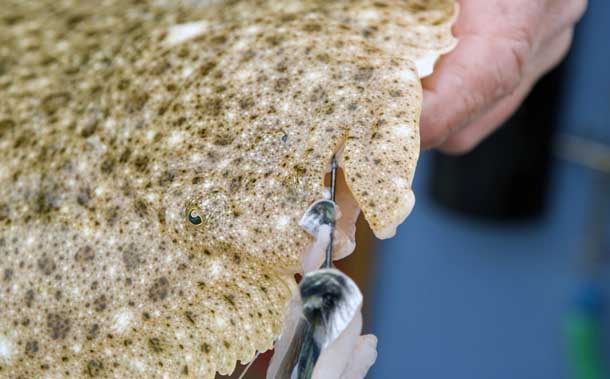
A portrait of a turbot.
Half an hour later we’re drifting back on to the Hood, dropping sandeels over the rusting hulk and hitting a few pollack. Not big fish, but lively two-pounders which we unhook and pop back. It’s hard work for the skipper, though, with the tide constantly threatening to push us into the steel hawser which stretches across the breakwater entrance. A doughty 16-footer with two anglers aboard has joined us, but isn’t enjoying the success we’re having. We all know, though, that theirs is the more suitable boat for this kind of thing.
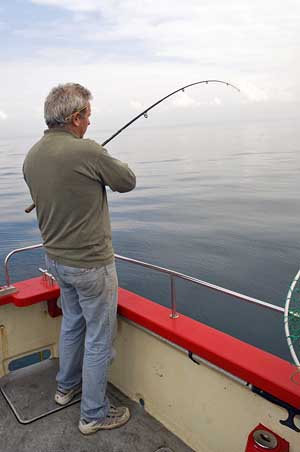 |
| Mark gets one on. |
>After half an hour, we’ve had enough, and pause only to give our remaining live sandeels to the guys in the clinker-built pot boat before heading off in search of mackerel.
By now, my phone’s red hot, the searing breath of an angry wife palpable over the ether as she demands to know when I’ll be back. I reassure her we’re on our way and, not long after, we are. Because, despite our best efforts, the sounder has shown clear space between the surface clutter and the bottom along the whole of the breakwater.
So I reflect on the day, as Mark Costley fillets our meagre catch, gulls kiting and wailing over the wake. Was it worth it? The sun’s dipping low now, burnishing the chalk at Ringstead Bay a gold that shimmers through the sea haze. Adie’s ribbing Mark Wheadon about something, and they both laugh. I stand in the breeze, drinking the sea air like springwater.
Yes. It was worth it. It always is.












